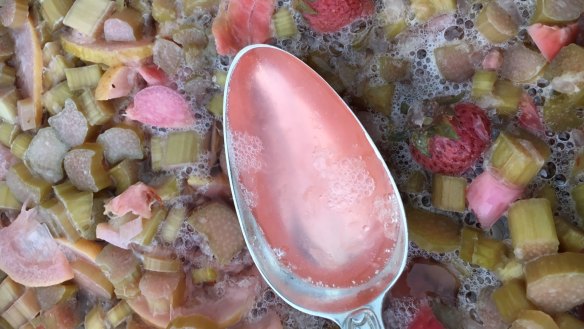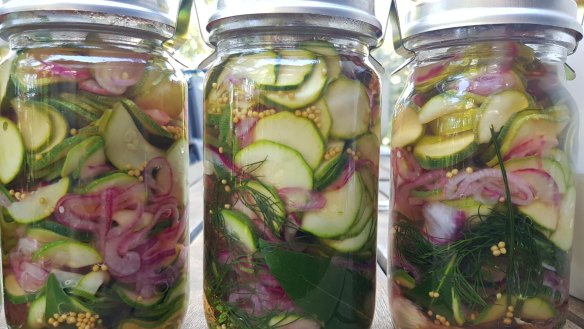Kitchen Garden: Canberra's sustainable harvest swap

In 2011 nine people met in the Canberra lounge room of Margaret O'Connor via a modest Facebook network aimed at people sharing information and resources relating to a wide range of sustainable living practices, such as swapping excess seeds.
To celebrate their 1000th member milestone, Urban Homesteading Group is getting together on Sunday February 18 to conduct a harvest swap. Members range from professional producers of sustainable foodstuffs on acreage to home owners in the suburbs and renters of small units with herbs in pots on their balconies.
There are three admins, Meryl McKerrow of Murrumbateman, Simone Dilkara of Holder and Margaret O'Connor. They moderate the group to protect its culture and so that members can develop their skills and connections with like-minded members and people who ask to be accepted in the group are screened to ensure they are genuine. So the gathering on Sunday is not a public event.

We met Margaret O'Connor as a Kitchen Gardener in January 2002. She lived in Cook then, and still does. Her garden is currently filled with strawberries, boysenberries, raspberries, mulberries, corn, tomatoes, pumpkins, pomegranates, apricots, peaches, apples and garlic. Margaret says she is still waiting for the bulk of the harvest to come in.
Simone Dilkara scrolled through recent posts on the Facebook site that will interest and amuse any readers who grow their own produce.
- Urban Homesteaders are currently waist deep in cucumbers, zucchini, beans, basil, plums, nectarines, the last of the apricots and the first of the apples.
- There's been a call out for something called "fish mint", which apparently smells just like it sounds.
- There are musings on how to tell when a spaghetti squash is ripe.
- A bit of a discussion about chooks and tape worms and also the best baits for mouse traps (peanut butter vs cheese) and the apparent preference by one member's mice for Camembert.
- The best place to forage blackberries.
- An ongoing counselling service for folk whose fruit trees are marauded by possums.
- Exchanges on the best ways to can or bottle tomatoes and fruit.
Simone says members variously keep bees, chickens, ducks, rabbits and worms. They are frenetic composters, recyclers, upcyclers, repurposers, sharers, encouragers, cheerers, laughers and helpers, swappers and gifters. Simone has shared a recipe for zucchini or pickling gherkin pickles.
In October 2015 we met Edwin Ride of Kambah as a Kitchen Gardener. He says, since then, he and his wife Sharon have progressed in leaps and bounds in their Homesteading and now they run sourdough bread workshops every month or so. Edwin says he is one of the overactive members (!) but not an admin of the group. Thanks to his keen home growing efforts, Edwin Ride has shared his recipe for those of us who think we all need a bit of fizz in our lives.
Simone's Ukrainian by marriage pickles
2kg zucchini or pickling gherkins sliced or whole
1kg red onions, sliced
half cup of salt
4 cups apple cider vinegar
2 cups sugar
4 tbsp yellow mustard seeds (put at least a teaspoonful in each jar)
lots of dill heads and leaves
some bay leaves
sliced horseradish
garlic cloves
Slice and salt zucchinis and onions for three hours. Drain and rinse and drain. Arrange zucchinis, onion, garlic, bay leaves, mustard seeds, dill and horseradish artfully into jars. Place vinegar and sugar into saucepan and bring to boil. Pour into jars leaving 1cm at the top. Seal jars. Place in a water bath and bring to the boil for five minutes or until zucchinis lose their bright green colour.
Edwin's rhubarb fizz
16 litres rainwater
2kg rhubarb
1kg of honey (from their own hive)
1kg of sugar (he uses white sugar but any combo of honey/sugar is a matter of taste - this recipe with these quantities of sweetener gives quite a dry result)
8 lemons (sliced finely, leave pith intact)
generous handful of strawberries
Put all together in a large container. Edwin uses a large stainless steel pot which is usually used for large batches of cheese! Just place a tea towel or cheesecloth over the top). No need to add yeast as there are plenty of wild yeasts in the fruit. You should see some signs of fizz in a couple of days - that's the yeast digesting the sugar to make alcohol and CO2. The longer you leave it the more alcohol develops. Strain and bottle after three days. The liquid makes about 16 litres. Recycled PET soda water/lemonade bottles are best, because they don't run the risk of exploding if they ferment too long.) Then leave for another 1-2 days at room temperature, then put in the fridge to halt fermentation. The fizz is ready to drink from that point on. Rescue the lemon slices, dredge them in caster sugar and let them dry. Instant candied peel. They are a treat.
The best recipes from Australia's leading chefs straight to your inbox.
Sign up